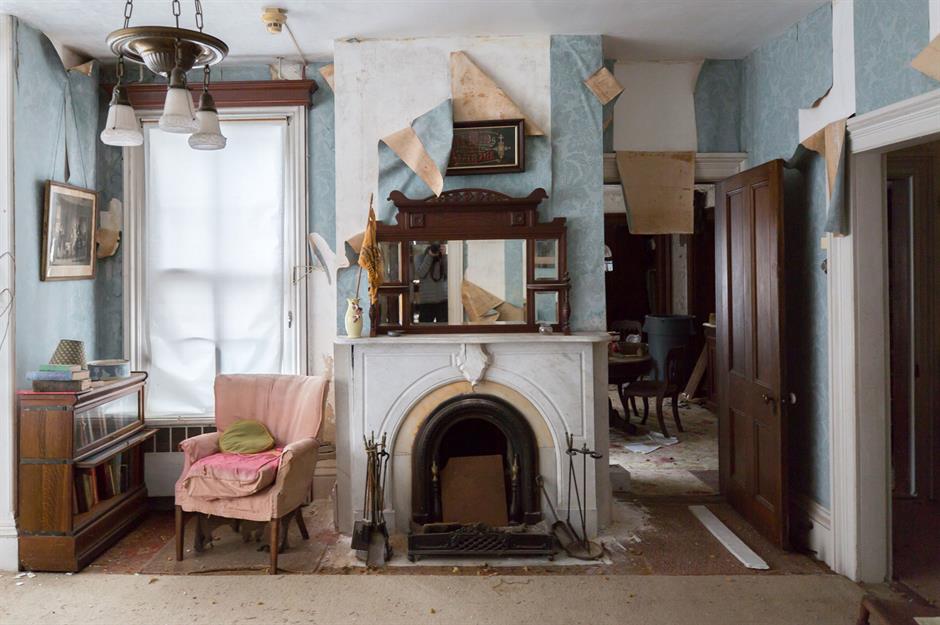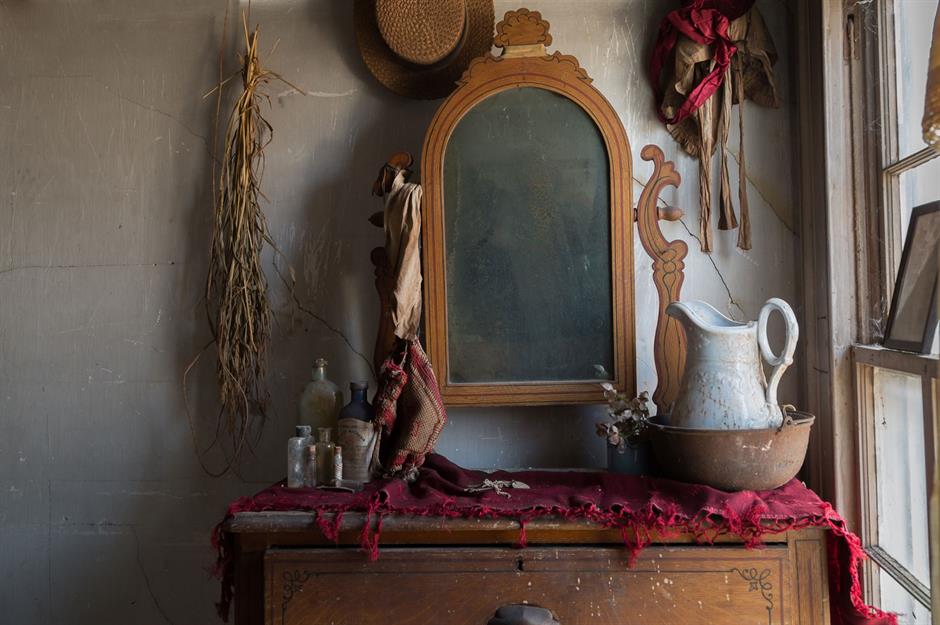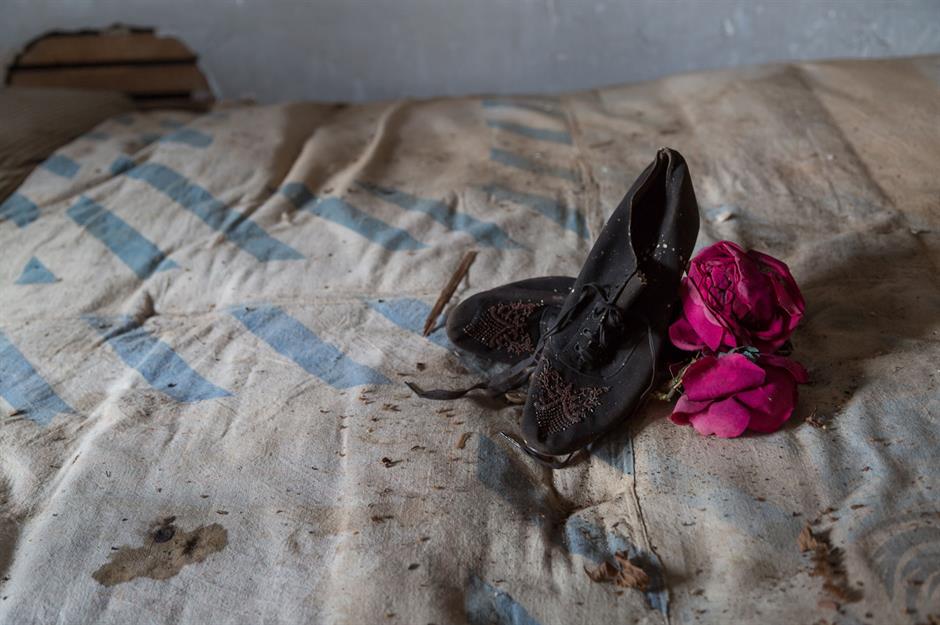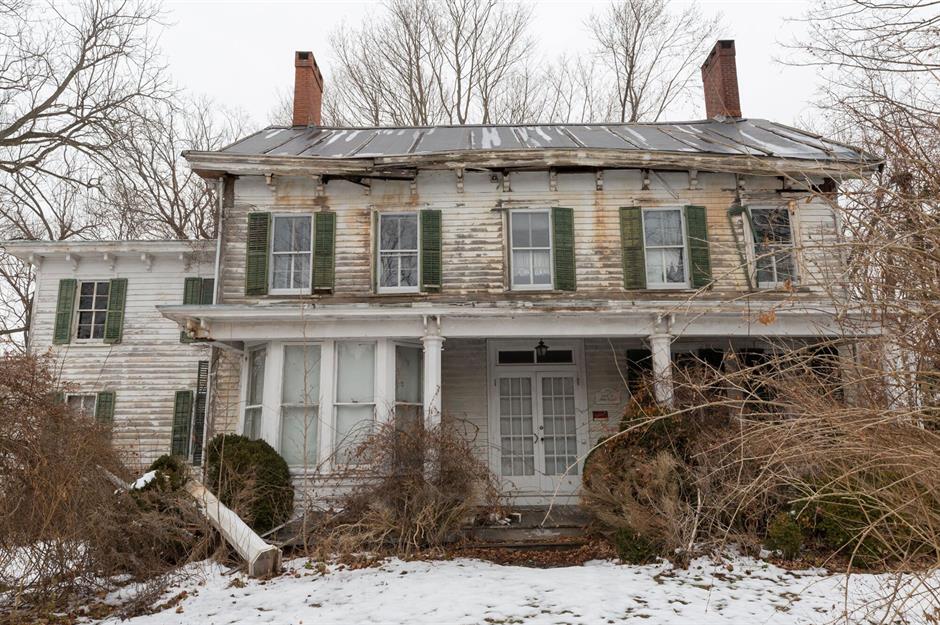Step inside the Marion Carll Farmhouse on Long Island, a captivating time capsule frozen in time. Despite years of abandonment stemming from financial constraints and legal disputes over ownership, this Victorian treasure remained untouched, preserving its vintage charm.
Thanks to photographer Bryan Sansivero, granted exclusive access by the local school board and district, we have the privilege of glimpsing into this enchanting property before its treasures were dispersed.
Join us on a journey back in time as we explore the Marion Carll Farmhouse, immersing ourselves in a bygone era filled with antiques, curios, and the echoes of history. Step through the threshold and let the whispers of yesteryears guide you through this captivating glimpse into the past.

Bryan Sansivero‘s lens captured the picturesque nine-acre farmstead nestled in the quaint hamlet of Commack, Suffolk County, New York. Its roots trace back to 1701, while the iconic clapboard farmhouse, a relic of history, was erected on the eve of the Civil War in 1860.

The farmstead derives its name from Marion Carll, a beloved figure in local lore, born in 1885. Marion Carll’s legacy extends beyond her years as a revered educator in the community; she pioneered the establishment of the area’s inaugural Parent-Teacher Association (PTA) and was honored with the dedication of a grammar school in 1957 in her name.

Upon her passing in 1968, Marion Carll bequeathed the farmhouse to the Commack School Board and District, stipulating its exclusive use for educational and historical purposes. While sporadic classes were once held by the Boards of Cooperative Educational Services (BOCES), funding woes led to their cessation in the 1990s, leaving the house and its environs vacant.

In 2012, descendants of Marion Carll initiated legal action against the school board and district, alleging a breach of the conditions outlined in their ancestor’s will. However, a ruling by a New York State Supreme Court judge affirmed the school board and district’s rightful ownership of the property.

Despite its dilapidated state, the farmhouse exudes an undeniable period charm, a testament to its bygone era. Marion Carll’s deliberate preservation of its 19th-century allure is evident, as the farmhouse remains adorned with an array of exquisite antiques and intriguing curiosities, offering a tantalizing glimpse into the past.

What a fascinating journey into the past! The parlour of the Marion Carll Farmhouse is a veritable time capsule, adorned with evocative pieces that transport us back in time. Take, for instance, the exquisite piano crafted by the esteemed New York City company Calenberg & Vaupel, a true relic of the mid-19th century, mirroring the farmhouse’s own history.

Scattered amidst the rooms are empty bottles, remnants of a bygone era, each holding traces of curious concoctions from days gone by. From the paint-stripping potion Pyranzine to the potent tincture of opium known as ‘Laudanum’, these artifacts offer a glimpse into the medical practices of yesteryears.

Despite the thick layer of dust that blankets the rooms, the farmhouse appears frozen in time, as if its former occupant has just stepped out momentarily. Take, for instance, the old sewing machine, positioned by the window in anticipation of its next use, had the blinds been drawn open to let the sunlight stream in.

Marion Carll’s penchant for preserving her valuables is evident in the presence of a safe manufactured by the renowned Hall’s Safe Company, a hallmark of quality craftsmanship since its establishment in the mid-19th century in Cincinnati. This safe stands as a testament to the enduring legacy of craftsmanship and security, a fitting addition to the farmhouse’s rich tapestry of history.

The Marion Carll Farmhouse boasts an array of stunning marble fireplaces that grace its rooms, adding an air of elegance to the rustic ambiance. Despite the peeling wallpaper, the farmhouse’s original features, such as the door frames and skirting boards, remain remarkably well-preserved, serving as a testament to the craftsmanship of yesteryears.

Charm abounds throughout the property, with retro homewares lending a nostalgic touch to the surroundings. Delicately embroidered cushions and blankets, alongside exquisite china pieces and even an enamel chamber pot filled with fabric flowers, evoke a sense of bygone charm and domesticity.

Photographs of the Carll family adorn the farmhouse, offering a glimpse into their genteel lifestyle. Clad in classy attire, the family members exude an aura of comfort and refinement, reflecting their affluent status.
RECOMMENDED: This Abandoned Mid-Century House Was Rescued From Ruin

While certain areas of the house appear to be in relatively good condition, others bear the marks of time and neglect, crying out for restoration efforts. Take, for instance, the decaying wall depicted here, a poignant reminder of the passage of time and the need for preservation to maintain the farmhouse’s storied legacy.

Marion Carll’s dedication to education is palpable throughout the farmhouse, evident in her possession of a writing bureau where she likely spent countless hours crafting letters and meticulously grading her students’ work.

The dining room stands as a testament to the farmhouse’s refined ambiance, with a sturdy wooden table commanding the center stage and an impressive cabinet showcasing the family’s prized china and glassware collection.

While the farmhouse exudes an aura of vintage charm, the occasional modern touch adds a unique flair to the space. Case in point: the attractive Art Deco fan, a striking contrast to the Victorian and early 20th-century objects adorning the property.

In Bryan’s lens, we catch a glimpse of yet another intriguing artifact—a bottle of Humphrey’s “30”, a homeopathic remedy aimed at addressing incontinence and bed-wetting. It’s fascinating to note that this classic remedy still finds its way onto shelves today, including online platforms like Amazon, preserving its place in both history and modern-day wellness practices.

In what appears to be the farmhouse kitchen, a charming dresser holds the family’s everyday crockery, featuring the timeless Blue Willow pattern—a beloved staple in American households from the late 19th century well into the 20th century.

Adorning the walls of this room are several historical prints, including a reproduction of John Trumbull’s renowned Declaration of Independence, originally painted in 1818 and famously depicted on the two-dollar bill.

In another captivating snapshot, we catch a glimpse of what seems to be the vintage bathroom or washroom of the farmhouse. The quintessential white clapboard walls reminiscent of nearby New England set the backdrop, while a lavish gilded mirror and an old-style water pump add to the room’s rustic charm.

Stepping into the master bedroom, we encounter a scene straight out of a period drama—a box of sewing threads and a dressmaking dummy adorned with an exquisite lace piece, presumably crafted by the skilled hands of Ms. Carll herself. This snapshot offers a glimpse into the meticulous attention to detail and craftsmanship that permeates every corner of the farmhouse.

In this wider view of the master bedroom, the toll of years of vacancy and neglect on the once meticulously maintained property is starkly evident. Paint peels off the walls, while debris litters the floor and furniture, painting a picture of desolation.

Adding to the room’s haunting atmosphere is an Art Deco relic—a wind-up Ingraham Meteor alarm clock dating back to 1936. Alongside it rests a dusty, empty bottle of C. C. Parsons’ Household Ammonia, a testament to the era’s essential cleaning products.

Bryan Sansivero’s lens captures more relics of bygone eras in this room, including dressmaking paraphernalia set against the backdrop of starkly cracked walls. The dummy, adorned in a corseted bodice and cage crinoline, harkens back to the elaborate fashions of the 19th century, lending an air of drama and eeriness to the space.

This evocative shot also showcases a chest of drawers repurposed as a wash table. Age-old toiletry products adorn the tabletop, accompanied by a jug, bowl, and antique towels—an intimate glimpse into the daily ablutions of yesteryears, frozen in time amidst the ruins of neglect.

Nestled on one of the linen-covered beds in the farmhouse rests a pair of black ballet-style shoes, perhaps painstakingly hand-embroidered by Marion Carll or another family member, accompanied by two delicate fabric roses—a poignant reminder of the lives that once flourished within these walls.

As we peer into the long hallway on the upper floor, the extent of the property’s deterioration becomes apparent. This particular wing of the house, once utilized to house slaves before the abolition of slavery in 1865, later served as quarters for the household’s servants.

In stark contrast, the adjacent bedroom appears relatively well-preserved, requiring little more than repapering to recapture its former splendor. Silk dresses, straw hats, and ballet shoes adorn the closet, alongside a dainty parasol—a snapshot of a bygone era frozen in time.

Turning our attention to the attic room, evidence of its former purpose as storage or sleeping quarters for domestic staff is palpable. Damp stains mar the ceiling, while rusty cage crinolines dangle from wooden hooks on the wall—a silent testament to the passage of time and the once-vibrant life that filled these now-forgotten spaces.

It’s heartening that Bryan‘s lens captured the timeless allure of this historic home, offering us a poignant glimpse into the bygone era and the life of a remarkable Long Island resident.
In a hopeful turn of events, in June 2019, Long Island University entered into a ten-year lease for six acres of farmland. This land is now being utilized for grazing animals, providing invaluable hands-on experience for the university’s veterinary college students to hone their clinical skills. By the lease’s end, the University will have contributed $145,000 (£114k) towards the use of the farm. The Board of Education has expressed its intent to allocate the proceeds from this lease towards the much-needed restoration of this majestic farmhouse, ensuring that its legacy endures for generations to come.
RECOMMENDED: Amazing Abandoned Homes Rescued From Ruin